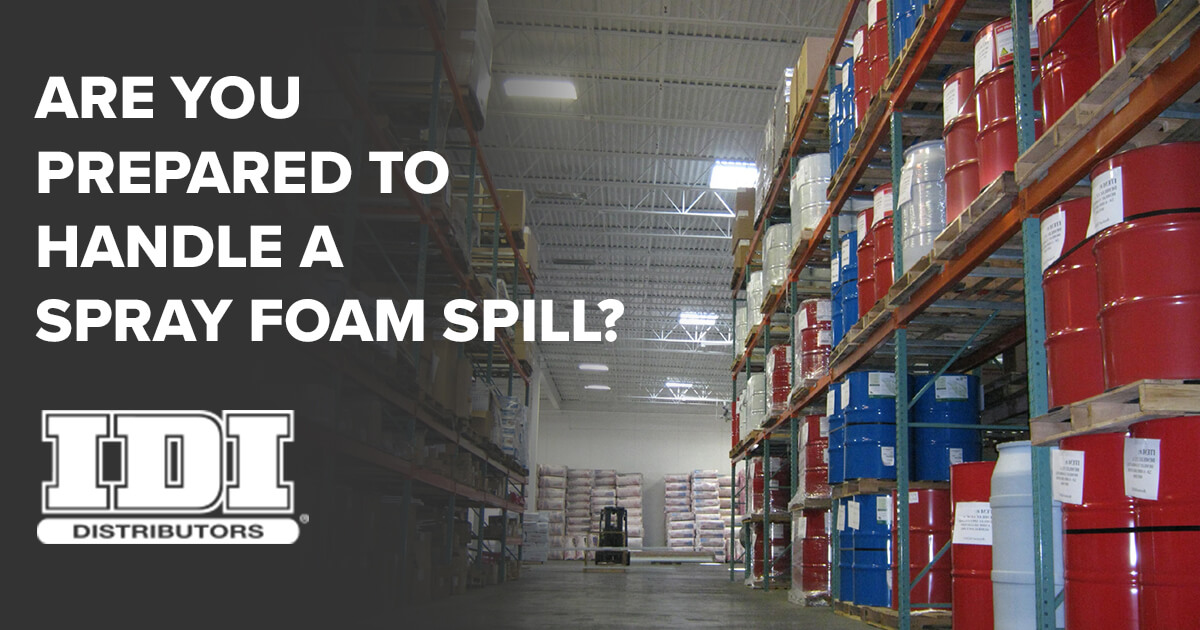Spray foam chemical spills are not fun to think about, but they are a legitimate concern. What happens if you have a spill at your job site or in your warehouse? Are you prepared? Are your employees prepared? Have you prepared your new hires? You have monthly safety meetings, don’t you? (If not, we’ll discuss that another time…)

Don’t panic — here are a few basics on how to handle a spray foam chemical spill to keep in mind.
What Causes Spills
First things first, let’s talk about what causes a spray foam chemical spill. The most common cause of spills is when a closed cell drum gets too hot creating extra pressure that overflows when you begin to open the bung. Another common instance of overflow occurs when water comes in contact with the A side. This can cause some overflow or, even worse, an eruption. Making sure that your drums are securely closed at all times is the best solution to preventing an overflow at your jobsite.
Spills don’t only occur on the jobsite, however. Spray foam chemical spills can occur at your warehouse as well. In a warehouse, spills can happen when a drum is dropped while it is being loaded, or while moving around in the trailer or truck. One of the most common causes of a chemical spill in a warehouse is the drum being punctured by the forks on a fork lift. The bottom line is, there are many ways accidents can occur.
Take care to keep chemical containers closed at all times and follow safety protocol in the warehouse, but in the event of a spill you can use these steps to begin cleaning up:
How to Handle a Spray Foam Chemical Spill
- When a spill does happen, first and foremost make sure there are no immediate safety risks. Check to make sure no one was injured during the incident and no chemical was spilled on anyone. If so, call 911 immediately. The top priority should always be to protect the people and workers in the area.
- Have a designated spot in your warehouse for your “spill kit” that contains:
- A copy of all SDS sheets for all products that could be spilled/leaked
- Tyvek suits
- Nitrile gloves
- Eye protection
- Cat litter or some other absorbing material
- Put on proper respiratory protection and appropriate PPE
- If possible, stop the spill by turning the drum so no further chemical can escape
- Depending on the size of the spill, small amounts of A-side chemicals can be reacted with small amounts of unused B-side chemicals to produce foam. Cured foam is typically non-hazardous, and if it is determined to be non-hazardous, cured foam can be disposed of as non-hazardous waste.
- Create a barrier to limit the spill using an absorbing material
- Place drum in a containment drum
- Dispose of spilled chemicals in compliance with regulations and codes
- Wash down spill area with aqueous detergent
Safety is an important topic in every industry, but especially so when working with chemicals. You must do your best to follow the safety guidelines outlined by the manufacturers. Check out CertainTeed’s Spray Foam Insulation Safety Guidelines for more information and tips.
It is important that everyone on your team always follows proper safety protocol and is prepared to handle a spill. If you and you’re team are prepared, spray foam chemical spills do not have to be treacherous. For further information on how to handle spray foam chemical spills, contact IDI Distributors today.
By Don Clymer
Don Clymer works for IDI as the National Spray Foam Sales Manager. For more information on spray foam standards and safety click here to find an upcoming training event near you >